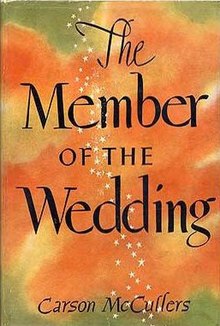| Carson McCullers in 1947, one year after the publication of The Member of the Wedding |
Beyond advancing a nearly a quarter century, we're making a rather precipitous temperamental leap between our second and third books of the semester, from the urban bustle and adult worries of Larsen's characters to the tumultuous adolescence of southern tomboy Frankie Addams, the 12 year old protagonist of Carson McCullers' The Member of the Wedding.
While William Faulkner was undoubtedly the leading voice in the Southern Gothic movement, a surprising number of women were among its finest practitioners, including Flannery O'Connor, Harper Lee, and McCullers, who might have left the south before beginning her career at the tender age of 23 with The Heart Is a Lonely Hunter (1940). McCullers' precocious prolificacy was fortunate for her readers, however, since accumulating bad health would catch up with her not long after the publication of The Member of the Wedding, with recurring strokes leaving her paralyzed on her right side, significantly affecting her ability to write.
Of all of her writing, The Member of the Wedding has perhaps had the busiest afterlife. Having been adapted for the Broadway stage by McCullers herself, it's undergone a number of revivals in the intervening years, and has also been reconfigured as a musical, a television drama, and twice as a film (in 1952 and 1997). The reason for this flexibility might be related to the novel's inherent simplicity: it features a cast of just three core characters (Frankie Addams, her African American maid and surrogate-mother Berenice Sadie Brown, and her six year old cousin John Henry West), and unfolds over the course of a few days within a relatively constrained setting. Nevertheless, this spartan structure serves as the perfect setting for a rich attentiveness to the rhythms of everyday life, and even more importantly the inner life of its young protagonist. Caught between childhood innocence and adulthood, Frankie suffers exquisitely, works her way through questions of identity and ambition, fantasizes, makes mistakes, and tries to learn from them, and we're along for the ride to enjoy every moment. There's a lot for us to empathize with here and a lot of grim humor as well, not to mention fascinating perspectives on shifting conceptions of race and gender within an evolving south.
Here's our reading schedule for The Member of the Wedding:
- Thurs. September 19: part one
- Tues. September 24: part two, chapters 1 and 2
- Thurs. September 26: part 2, chapter 3 and part 3
And here are some supplemental resources for the book:
- The Guardian (UK) hails The Member of the Wedding as an "overlooked classic": [link]
- The Independent (UK) diagrees, calls it a "book of a lifetime": [link]
- Not wanting to miss out on unfiltered praise, PANK reviewer Sara Watson (once a grad student here at UC) sees it as a "book we can't quit": [link]
- The Carson McCullers Project homepage for the book (and its subsequent adaptations): [link]


Is Frankie actually mature or is it an act to try and fit in with the adults after kids her age excluded her
ReplyDeleteDo you think Frankie will actually run away after the wedding?
What's the timeline of the novel?
ReplyDeleteLet's talk about gender performance and pre-established expectations.
What does F. Jasmine really think is going to happen at the wedding?
What do the characters thing about the power of names and identity?
What questions concerning race are raised here?
On page 148, when Frankie realizes that she will not be taken to jail, it reads, “In a way she was sorry. It was better to be in a jail where you could bang the walls than in a jail you could not see” (148). What evidence do you see that there is a “jail” surrounding Frankie? What is that jail?
ReplyDeleteWhy do you think the wedding scene was so short? How did you feel about the ending?